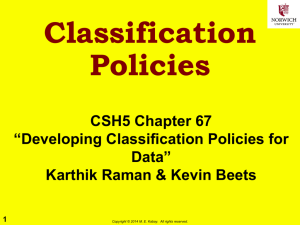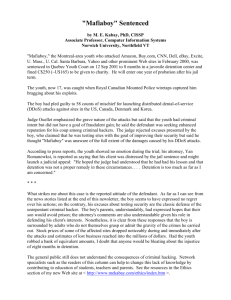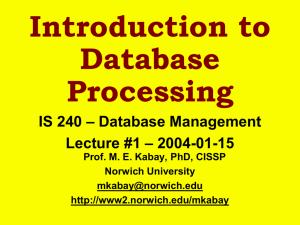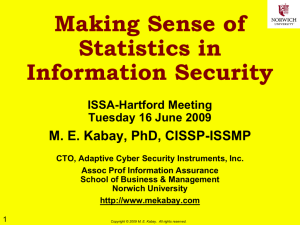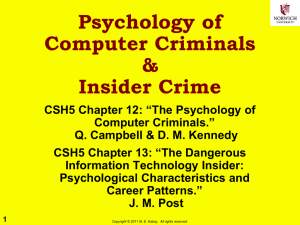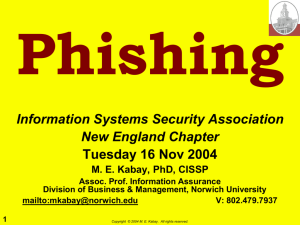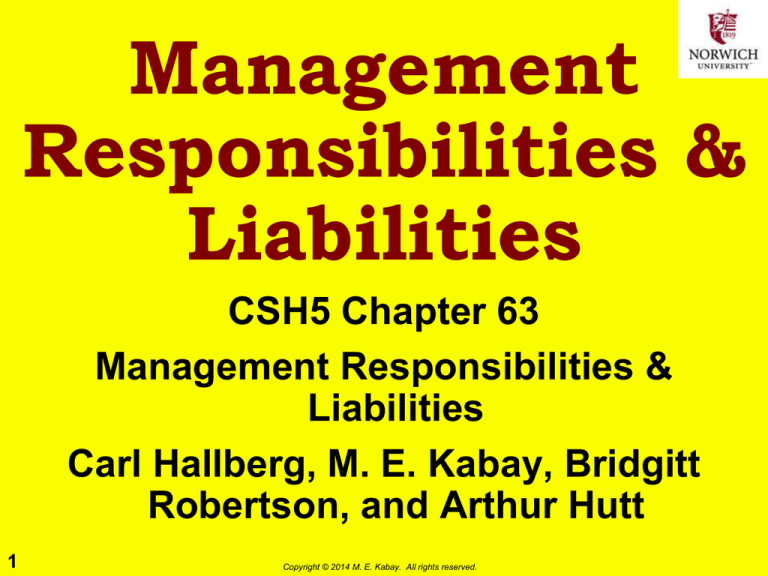
Management
Responsibilities &
Liabilities
CSH5 Chapter 63
Management Responsibilities &
Liabilities
Carl Hallberg, M. E. Kabay, Bridgitt
Robertson, and Arthur Hutt
1
Copyright © 2014 M. E. Kabay. All rights reserved.
Topics: Integration of Many
Previous Chapters / Lectures
Introduction
Responsibilities
Liabilities
Computer Management
Functions
Security Administration
2
Copyright © 2014 M. E. Kabay. All rights reserved.
Introduction
Security serves corporate mission
Different balance in each organization
Low risk, high tolerance
High risk, low tolerance
Management provides essential framework
Heterogeneous networks complicate
management task
Increased publicity about IT security failures
raises visibility of internal security managers
Helps by sensitizing colleagues
Hurts by causing overreaction
3
Copyright © 2014 M. E. Kabay. All rights reserved.
CISO
Chief Information Security Officer
CitiBank first to name CISO
Steven Katz (early 1990s)
in wake of Vladimir Levin attack
Reports at same level as other
C-officers (CEO, CFO, COO…)
Functions include all aspects of managing
and long-term planning for information
security
Coordination with physical/facilities security,
IT, legal department
QUESTION: why report at same level as other
C-officers? Why not to CIO?
See also CSH5 Chapter 65 for further details of the role of the CISO.
4
Copyright © 2014 M. E. Kabay. All rights reserved.
IS & Strategic Vision
Focus on mission-critical functions
Poor security can affect all stakeholders
Including current & potential customers
Increasing reluctance to work with
organizations w/ poor security
Security focus can improve
overall attention to detail,
planning – benefits throughout
Define roles & responsibilities
in IT-security group
Manage expectations of other
executives
5
Copyright © 2014 M. E. Kabay. All rights reserved.
NPV (Net Present Value) of
Good Security
Traditional views of security
Risk avoidance
Loss prevention
Loss mitigation
Competitive marketplace puts
positive value on visible
security
Customer confidence
Market share
Increased profits
In government or non-profit cases, good IA can
support public confidence, use of services or
donations
6
Copyright © 2014 M. E. Kabay. All rights reserved.
Veterans Affairs Case Study
Announcement without taking responsibility
Unencrypted mobile data – stolen
Personally identifiable information (PII) – loss
of control
Systematic management failures –
widespread refusal to follow established
government security guidelines & standards
Contractor involvement – many
breaches traced to occasional
workers
Analysis & response – new
policies limiting portable devices,
forcing encryption, adding
security officials
7
See http://www.mekabay.com/infosecmgmt/vasaga.pdf
Copyright © 2014 M. E. Kabay. All rights reserved.
Responsibilities
Overall Goals of Security Management
Policy Management
Motivation
Supervision
Judgement &
Adaptation
Management Failures
Risk Management
8
Copyright © 2014 M. E. Kabay. All rights reserved.
Overall Goals of Security
Modern organizations depend on information
Confidentiality
The Parkerian
Control
Hexad
Integrity
Authenticity
Availability
Utility
Maintain entire infrastructure
including technical and human
factors supporting these
attributes of information
Meet business needs
cost-effectively
9
Define metrics and standards
for security processes and
procedures
Copyright © 2014 M. E. Kabay. All rights reserved.
CISO & Policy Management
People take more of managers’
time than technical issues
Hire right people using security
evaluations
Train, supervise, promote, fire
personnel with attention to
security issues
Motivate, encourage, retain
personnel to improve security
Comply with corporate policies,
regulations, laws to avoid security
breaches & their consequences
CISO does NOT write detailed
policies such as password rules
10
Copyright © 2014 M. E. Kabay. All rights reserved.
Motivation Important
Security policies often perceived as nuisance
Interfere with fundamental goals
Upper management must set example
Punishment not most effective motivator
Theory X assumes that people need
punishment to keep them up to standard
because they are
Lazy
Unmotivated
Dishonest
Theory Y assumes that people
Like to excel
Enjoy their work if possible
Will be honest most of the time
Respond well to praise and reward
11
Copyright © 2014 M. E. Kabay. All rights reserved.
Motivation (cont’d)
Challenging staff can keep them interested in
security
Security courses
Professional security associations
Conferences about INFOSEC
Contests
Writing articles
Camaraderie can help – but only voluntary
Outings, sports, teams, picnics….
Journal “brown bag” lunch clubs….
NEVER force people into such activities
Be careful about invading private time
Knowledge-sharing
Adequate resources for assigned tasks
12
Copyright © 2014 M. E. Kabay. All rights reserved.
Supervision
Errors & omissions by staff major component
of harm to IT systems
Poorly-trained employees
Bored or careless employees
Analyze all incidents that harm production
Determine root causes
Solve them!
Management by walking around (MBWA)
Tremendously valuable tool
Real-time information about mood,
problems
Absorb more than explicit details – sense
atmosphere
Try at least an hour a week
13
Copyright © 2014 M. E. Kabay. All rights reserved.
Judgement & Adaptation
Dilbert caricatures managers who
have no clue about mission-critical
functions
Listen to the employees and respond
to their concerns honestly and openly
NEVER ignore required reports from staff
Short-term perspective can ruin prospects for longterm success; e.g.,
Insisting on cheaper solution now may cause
long-term costs
Requiring high-security measures without
attention to reality may interfere with required
processes
Management stupidity may lead to rebellion and
side-stepping all security
14
Copyright © 2014 M. E. Kabay. All rights reserved.
Classic Security-Mgmt Failures
15
Hasn’t happened here – so don’t need security
Security as afterthought
Security solely as cost with
no benefit
Using only free security systems
Novices managing computers
Tolerating illegal activities
on corporate systems
Failing to patch known
vulnerabilities
Trusting mobile code without
checking trustworthiness
Allowing automatic execution of document macros
Treating people as fungible (replaceable units)
Not sharing security-failure information
Copyright © 2014 M. E. Kabay. All rights reserved.
Risk Management
Causes of damage
Physical hazards
Equipment malfunction
Software malfunction
Human error
Misuse of data
Loss of data
Also classify by
Magnitude of loss
Probability of loss
Permanency of damage
16
Copyright © 2014 M. E. Kabay. All rights reserved.
Liabilities
Summary of Liabilities
Case Study
Stakeholders
Due Diligence of Care
Downstream Liability
Audits
17
Copyright © 2014 M. E. Kabay. All rights reserved.
Summary of Liabilities
Loss of revenue
Loss of reputation
Loss of business-partner
confidence
Loss of consumer confidence
Loss of enterprise valuation
Failure of the entire enterprise
And all of these can result in a loss of trust.
18
Copyright © 2014 M. E. Kabay. All rights reserved.
Case Study: VeriSign
In 2001, VeriSign issued Microsoft
cryptographic certificates to non-Microsoft
crooks
Tremendous blow to VeriSign’s credibility as
a Certificate Authority
Response was exemplary
Immediate, open public
information about failure
of their processes
Open process to resolve error
Did not lose public confidence
Stock price even rose
Still in business as leading CA for SSL
(47% of global market in June 2004)*
* http://www.internetnews.com/xSP/article.php/3379001
19
Copyright © 2014 M. E. Kabay. All rights reserved.
Stakeholders*
* Anyone affected by a corporate policy
(or disaster)
Stockholders
Employees
Customers
Potential customers
Suppliers
Data subjects
Regulatory agencies and law enforcement
Downstream victims
Permission for use of graphic
requested from copyright owner.
20
Copyright © 2014 M. E. Kabay. All rights reserved.
Due Care & Diligence
Research & analysis to
establish risks & appropriate
defenses
Especially important in
mergers & acquisitions
Slowly gaining support for
standards such as ISO 17799
Compliance with local laws
contributing to respect for
due diligence
European Privacy Directive
US HIPAA, GLB, SOx
21
Copyright © 2014 M. E. Kabay. All rights reserved.
Downstream Liability
Theory has been popular for a
decade
Fail to protect your system
against compromise
Criminals use your
compromised system to harm
victims
Victims sue you (as civil tort)
for contributory negligence
No successful cases to date
(2014)
The few attempts on record have
been rejected by courts so far
22
Copyright © 2014 M. E. Kabay. All rights reserved.
Audits
Audits important tool to
demonstrate due diligence
Assess level of compliance
with policy
Distinct from
assessment which can
be broader in scope
Definitely not same as
penetration test
Adopt non-adversarial
stance for most effective
cooperation of staff
Auditors should listen to
explanations for deviations
from policy and include
them in reports
23
Copyright © 2014 M. E. Kabay. All rights reserved.
Recent US Legislation
SOX
GLB
See CSH5 Chapter 64 for details.
HIPAA
24
Copyright © 2014 M. E. Kabay. All rights reserved.
Sarbanes-Oxley
Implemented 2002
Enacted after the Enron and WorldCom
scandals
Developed by Paul Sarbanes (D-MD) & Michael
Oxley (R-OH)
Regulates corporate financial records
Penalties for abuse
Defines types of records to archive
Prohibits data falsification
For more information, see
http://www.sec.gov/divisions/corpfin/faqs/soxact2002.htm
25
Copyright © 2014 M. E. Kabay. All rights reserved.
Gramm-Leach Bliley Act
“GLB” or “GLBA”
Enacted 1999; effective mid-2001
Every financial institution shall protect the
security and confidentiality of its customers'
confidential personal information
Data subjects must
Be informed of privacy policies and
Have opportunity to inspect and correct
their own records
For more info, see
http://www.ftc.gov/privacy/privacyinitiatives/glbact.html
26
Copyright © 2014 M. E. Kabay. All rights reserved.
HIPAA
Health Insurance Portability and Accountability
Act of 1996
AKA “Kennedy-Kassebaum Act”
Title I protects employees' health insurance
coverage when they change or lose their jobs
Title II
Standards for patient health, administrative and
financial data interchange
Privacy & security of health information records
and transactions
Took effect 2001; compliance targets through 2004
For more information, see
http://www.cms.hhs.gov/HIPAAGenInfo/
27
Copyright © 2014 M. E. Kabay. All rights reserved.
Computer Management
Functions
Overview of
Management
Planning for
Computer Security
Organizing
Integrating
Controlling
28
Copyright © 2014 M. E. Kabay. All rights reserved.
Overview of Management
29
Understand that security
management is a process,
not a state
The better your security,
the less immediate
evidence there may be
of its effects
Therefore keep records
of attacks
Include intrusion-detection outside your
perimeter as well as inside
Define scope with clear metrics and standards to
establish success or failure
E.g., define specific service-level agreements
(SLAs) for availability
Copyright © 2014 M. E. Kabay. All rights reserved.
Planning for Computer
Security
Communicate constantly with upper
management
No surprises
Never blind-side your boss
Coordinate security of IT with all other sectors
(e.g., HR, PR, finance, accounting, production,
research…)
Communicate goals and successes throughout
the organization
Security-awareness tools (as previously
discussed)
Newsletters, reports etc.
30
Copyright © 2014 M. E. Kabay. All rights reserved.
Organizing
Obtaining resources of
personnel, money, and facilities
adequate to accomplish assigned
mission
Fitting responsibly into
organizational pattern
Assigning responsibility and
authority to individuals
Formulating supporting methods
and procedures
Measuring organizational
effectiveness
31
Copyright © 2014 M. E. Kabay. All rights reserved.
Integrating Security
Integrating security into all
areas of work from ground
up (not as retrofit)
Accountability for
security in job
descriptions
Training programs
include security
Supervisors include security compliance
Explicit responsibility for overall security
Avoid conflicts of interest (COO, CIO, CFO
should not be CISO)
Policies should drive written standards and
procedures
32
Copyright © 2014 M. E. Kabay. All rights reserved.
Controlling
Develop metrics tied to security
goals
Define standards (objectives)
Analyze results promptly
Take corrective action at once
Avoid making these processes
punitive – will result in
dissimulation, falsification of data,
and resentments among staff
33
Copyright © 2014 M. E. Kabay. All rights reserved.
Security Administration
Staffing the Security Function
Authority and Responsibility
Professional Accreditation & Education
34
Copyright © 2014 M. E. Kabay. All rights reserved.
Staffing the Security Function
Titles vary
Information security administrator
Computer security manager
Information systems security officer
Chief information security officer
Look for management and technical abilities
Work with both technical staff and managers
Communicate (speak, write) well
Understand cost/benefit analysis, finances
Know industry if possible
35
Copyright © 2014 M. E. Kabay. All rights reserved.
Authority and Responsibility
Do not separate authority and
responsibility
Essential that those charged with
the responsibility to accomplish
a job have the authority to
succeed
Some typical responsibilities
Establish policy statements
and guidelines for information
protection
Identify vulnerabilities and risks
Recommend protective measures
Control implementation of protective measures
Measure effectiveness of security precautions
Promote security awareness and security education
Achieve professional accreditation
36
Copyright © 2014 M. E. Kabay. All rights reserved.
Examples of Certification
CCP (Certified Computing Professional with
specialty including Systems Security) from
the Institute for Certification of Computer
Professionals (ICCP, www.iccp.org)
CDRP (Certified Disaster Recovery Planner)
from the Disaster Recovery Institute
International (DRII, www.drii.org)
CFE (Certified Fraud Examiner) from the
Association of Certified Fraud Examiners
(ACFE, www.acfe.org)
CIA (Certified Internal Auditor) from the
Institute of Internal Auditors (IIA,
www.theiia.org)
CISA (Certified Information Systems Auditor)
from the Information Systems Audit & Control
Association (ISACA, www.isaca.org)
37
Copyright © 2014 M. E. Kabay. All rights reserved.
Examples of Certification
(cont’d)
CISSP (Certified Information Systems
Security Professional) from the International
Information Systems Security Certification
Consortium (ISC)2; Web site www.isc2.org
ISSxP (Information Systems Security
{Architecture / Engineering / Management}
Professional) specializations of CISSP
CPP (Certified Protection Professional) from
the American Society for Industrial Security
(ASIS, www.asisonline.org)
MSIA (Master of Science in Information
Assurance) from Norwich University; Web
site www.msia.norwich.edu
See also CSH5 Chapters 74, 75 & 76
38
Copyright © 2014 M. E. Kabay. All rights reserved.
Review Questions
1. Why can’t we simply establish uniform standards of
information security that can be applied to all
organizations equally?
2. Under what circumstances could good IA be a positive
factor for the profitability or other measures of success of
an organization?
3. What are the six fundamental attributes of information that
IA must protect?
4. What’s a security metric and how is it related to a security
standard?
5. Why do you think that people-related issues take more
time for IA managers than technical issues?
6. How is it that IA managers have to consider motivational
psychology as part of their job?
39
Copyright © 2014 M. E. Kabay. All rights reserved.
Review Questions
7. Why do you think that MBWA could improve IA in an
organization?
8. How can an IA manager avoid the pitfalls lampooned in
Dilbert cartoons?
9. What were the characteristics of VeriSign’s response to its
2001 failures in the Microsoft certificate case that helped
avoid a public-relations disaster for the company?
10. Why should we be concerned with more than just
customers when considering the consequences of
security failures? Who are these other stakeholders?
11. What is meant by exercising due care and diligence in
implementing security policies?
12. What is meant by downstream liability in discussions of
security policy?
40
Copyright © 2014 M. E. Kabay. All rights reserved.
Review Questions
13. How can you help security audits be successful?
14. What are the key elements for successful planning of
computer security?
15. What are the key elements for organizing the security
function?
16. How can you integrate security into the corporate culture?
17. What are some of the attributes of the ideal information
assurance manager?
18. Why should we ensure that authority accompanies
responsibility?
19. Expand the acronyms CCP, CDRP, CFE, CISA, CISSP,
ISSMP, CPP and MSIA.
41
Copyright © 2014 M. E. Kabay. All rights reserved.
DISCUSSION
42
Copyright © 2014 M. E. Kabay. All rights reserved.


